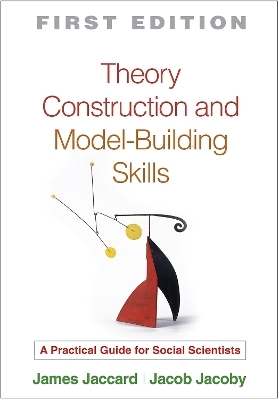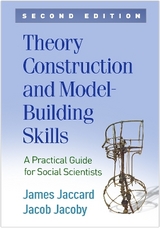
Theory Construction and Model-Building Skills, First Edition
Guilford Publications (Verlag)
978-1-60623-340-5 (ISBN)
- Titel erscheint in neuer Auflage
- Artikel merken
James Jaccard, Jacob Jacoby
I. BASIC CONCEPTS1. IntroductionOrganization of the BookTheories and Settings2. The Nature of UnderstandingThe Nature of RealityHow Reality Is ExperiencedConcepts: The Building Blocks of UnderstandingThe Nature of ConceptsConcepts, Constructs, and VariablesConceptual Systems: The Bases for Deeper UnderstandingCommunicationSummary and Concluding CommentsSuggested ReadingsKey TermsExercises3. Science as an Approach to UnderstandingSocially Based Approaches to UnderstandingCommonalities across All Shared Conceptual ApproachesSpecial Features of the Scientific ApproachThe Essentials of Scientific EndeavorThe Process of Theory ConstructionWhat Is a Theory?Theories, Models, and HypothesesTypes of TheoriesThe Role of Theory in Basic versus Applied ResearchCharacteristics of a Good TheoryScience and ObjectivitySummary and Concluding CommentsSuggested ReadingsKey TermsExercisesII. Core Processes4. Creativity and the Generation of IdeasIntroductionOne Small Step for ScienceCreativityThe Creative PersonCreative IdeasThe Creative ProcessDeciding to Be CreativePractical Implications for Theory ConstructionChoosing What to Theorize AboutLiterature ReviewsHeuristics for Generating IdeasIdea Generation and Grounded/Emergent TheorizingTwenty-Six HeuristicsWhen the Focus Is on Basic Mental or Biological ProcessesScientists on Scientific TheorizingSummary and Concluding CommentsSuggested ReadingsKey TermsExercises5. Focusing ConceptsThe Process of InstantiationThe Nature of Conceptual DefinitionsShared Meaning, Surplus Meaning, and Nomological NetworksPractical Strategies for Specifying Conceptual DefinitionsMultidimensional ConstructsCreating ConstructsAn Example of Specifying Conceptual DefinitionsOperationismSummary and Concluding CommentsSuggested ReadingsKey TermsExercises6. Clarifying Relationships Using Thought ExperimentsThought Experiments for Relationships in Grounded and Emergent TheoryDescribing Relationships with Different Types of VariablesThought Experiments for Relationships between Categorical VariablesCategorical Variables with Two LevelsCategorical Variables with More Than Two LevelsThought Experiments for Relationships between Quantitative VariablesScatterplotsCharacteristics of Linear RelationshipsNonlinear RelationshipsWhen Nonlinear Relationships Are LinearA Thought Experiment with Hypothetical ScatterplotsThought Experiments for Relationships between Categorical and Quantitative VariablesThought Experiments for a Categorical Cause and a Quantitative Effect: The Use of Hypothetical MeansThought Experiments for a Quantitative Cause and a Categorical Effect: The Use of Hypothetical ProbabilitiesThought Experiments for Moderated RelationshipsThought Experiments Using Hypothetical Factorial DesignsHypothetical Factorial Designs with More Than Two LevelsHypothetical Factorial Designs with Quantitative VariablesHypothetical Scatterplots and Quantitative VariablesSummary for Moderated RelationshipsBroader Uses of Hypothetical Factorial Designs in Thought ExperimentsRelationships Characterized by Main EffectsRelationships Characterized by Simple Main EffectsRelationships Characterized by Interaction ContrastsChoice of the Moderator VariableSummary and Concluding CommentsSuggested ReadingsKey TermsExercisesAPPENDIX 6A. Thought Experiments for a Quantitative Cause and Categorical Effect: A Hypothetical Contingency Table MethodAPPENDIX 6B. Thought Experiments for Moderated ModerationIII. Frameworks for Theory Construction7. Causal ModelsTwo Types of Relationships: Predictive and CausalPredictive RelationshipsCausal RelationshipsCausality and Grounded/Emergent TheoryTypes of Causal RelationshipsConstructing Theories with Causal RelationshipsIdentifying Outcome VariablesIdentifying Direct CausesIndirect Causal RelationshipsTurning Direct Relationships into Indirect RelationshipsPartial Mediation versus Complete MediationAn Alternative Strategy for Turning Direct Effects into Indirect EffectsThe Essence of MediationModerated Causal RelationshipsMediated ModerationModerated MediationModerated ModerationSummary of Moderated RelationshipsReciprocal or Bidirectional CausalityThere Is No Such Thing as Simultaneous Reciprocal CausalityFeedback Loops: Adding Mediators to Reciprocal CausationModerated Reciprocal CausationSpurious RelationshipsAdding Additional OutcomesAdding Effects of EffectsSpecifying Causal Relationships between Existing VariablesSummary of Additional Steps That May Create SpuriousnessUnanalyzed RelationshipsExpanding the Theory FurtherTemporal DynamicsDisturbance TermsLatent Variables, Structural Theory, and Measurement TheoryRevisiting Your Literature ReviewSome Final StepsPerspectives on the Construction of Causal TheoriesPath Diagrams as Theoretical PropositionsA Note on Research Design and Statistical AnalysisElaborating the Logic Underlying Each PathThe Use of Causal Analysis in Grounded/Emergent TheorizingSummary and Concluding CommentsSuggested ReadingsKey TermsExercises8. Mathematical ModelsTypes of Variables: Categorical, Discrete, and ContinuousAxioms and TheoremsFunctionsLinear FunctionsThe Slope and InterceptDeterministic versus Stochastic ModelsModel ParametersAdjustable Parameters and Parameter EstimationRates and Change: Derivatives and DifferentiationInstantaneous ChangeSecond and Third DerivativesDescribing Accumulation: Integrals and IntegrationJust-Identified, Overidentified, and Underidentified ModelsMetricsTypes of NonlinearityLogarithmic FunctionsExponential FunctionsPower FunctionsPolynomial FunctionsTrigonomic FunctionsChoosing a FunctionFunctions for Categorical VariablesAdvanced Topics: Manipulating and Combining FunctionsFunction TransformationsCombining FunctionsMultiple Variable FunctionsPhases in Building a Mathematical ModelAn Example Using Performance, Ability, and MotivationAn Example Using Cognitive AlgebraAn Example Using Attitude ChangeAn Example Using a Traditional Causal ModelChaos TheoryCatastrophe TheoryAdditional Examples of Mathematical Models in the Social SciencesEmergent Theory Construction and Mathematical ModelsSummary and Concluding CommentsAPPENDIX 8A. SPSS Code for Exploring Distribution PropertiesAPPENDIX 8B. Additional Modeling Issues for the Performance, Motivation, and Ability ExampleSuggested ReadingsKey TermsExercises9. Simulation as a Theory Development MethodDefining SimulationsThe Uses of Research SimulationsThe Difference between Simulation and Laboratory ExperimentsBasic Simulation VarietiesAll-Machine versus Person-Machine SimulationsDescriptive versus Analytic SimulationsReal-Time versus Compressed-Time versus Expanded-Time SimulationsDeterministic versus Nondeterministic SimulationsFree versus Experimental SimulationsMacro- versus MicrosimulationsContent-Oriented SimulationThe Analysis of Criterion Systems as a Basis for Theory ConstructionSimulation of Information Accessing in Consumer Purchase DecisionsVirtual Environments and AvatarsSimulations and Virtual ExperimentsAgent-Based ModelingResources for Conducting SimulationsSummary and Concluding CommentsSuggested ReadingsKey TermsExercises10. Grounded and Emergent TheoryGrounded and Emergent Theory: An OverviewPositivism "versus" ConstructivismFraming the ProblemThe Role of Past LiteratureCollecting Qualitative DataArchival RecordsDirect ObservationStructured and Unstructured Interviews and SurveysFocus GroupsVirtual EthnographiesDirective Qualitative MethodsMixed-Methods ResearchMemo WritingTheoretical SamplingAnalyzing and Coding DataAn Example from AnthropologyThe Statistical Exploration of RelationshipsProcess Analysis in Emergent TheorizingMoving to Theoretical Statements: Using Principles of RhetoricDeduction, Induction, and AbductionToulmin's Model of ArgumentationWeak ArgumentsAPPENDIX 10A. The Limits of Information ProcessingSummary and Concluding CommentsSuggested ReadingsKey TermsExercises11. Historically Influential Systems of ThoughtGrand TheoriesMaterialismStructuralismFunctionalismSymbolic InteractionismEvolutionary PerspectivesPostmodernism: A Critical Commentary on Grand TheoriesFrameworks Using MetaphorsNeural NetworksSystems TheoryFrameworks Emphasizing Stability and ChangePsychological FrameworksRei
| Erscheint lt. Verlag | 10.5.2010 |
|---|---|
| Reihe/Serie | Methodology in the Social Sciences |
| Verlagsort | New York |
| Sprache | englisch |
| Maße | 178 x 254 mm |
| Themenwelt | Sozialwissenschaften ► Soziologie ► Empirische Sozialforschung |
| ISBN-10 | 1-60623-340-8 / 1606233408 |
| ISBN-13 | 978-1-60623-340-5 / 9781606233405 |
| Zustand | Neuware |
| Haben Sie eine Frage zum Produkt? |
aus dem Bereich



